See Comet C/2025 R2 (SWAN)!
Astronomers have spotted a new visitor to our skies: Comet C/2025 R2 (SWAN). This comet takes more than 22,000 years to orbit the sun, making it a true once-in-a-lifetime visitor. Images show a long, beautiful tail. It might brighten enough to be seen without binoculars. Join Bob King – aka AstroBob – and EarthSky’s Deborah Byrd in this video as they explore Comet SWAN – how it was discovered, where to find it in the sky and what to expect. Plus view beautiful images! Watch in the player above or on YouTube.
Finder chart for comet C/2025 R2 (SWAN)
 A new comet, C/2025 R2 (SWAN), is barely visible to the eye. But binoculars will show it! Right now, it’s about halfway between Mars and the star Zubenelgenubi in the west after sunset. Here’s a chart to track down Comet SWAN R2 from now until October 2. Face west-southwest just after sunset. Image via Eddie Irizarry/ Stellarium.
A new comet, C/2025 R2 (SWAN), is barely visible to the eye. But binoculars will show it! Right now, it’s about halfway between Mars and the star Zubenelgenubi in the west after sunset. Here’s a chart to track down Comet SWAN R2 from now until October 2. Face west-southwest just after sunset. Image via Eddie Irizarry/ Stellarium.
Read more: New comet C/2025 R2 (SWAN) is becoming more visible
September 25 evening: Moon and Mars
 Shortly after sunset tonight, September 25, look for the waxing crescent moon, still close to the western horizon. The lit portion of the growing crescent moon will point at Mars tonight. They’ll set not long after sunset. Chart via EarthSky.
Shortly after sunset tonight, September 25, look for the waxing crescent moon, still close to the western horizon. The lit portion of the growing crescent moon will point at Mars tonight. They’ll set not long after sunset. Chart via EarthSky.
Our charts are mostly set for the northern half of Earth. To see a precise view – and time – from your location, try Stellarium Online.
Late September evenings: 2 visible planets
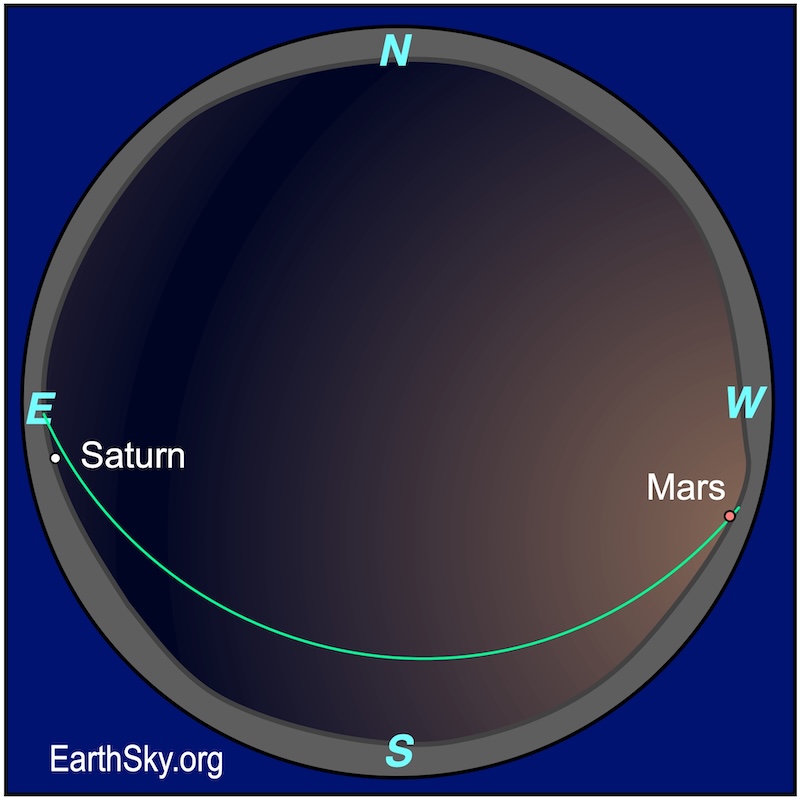 Starting this week, there will be 2 visible planets in the evening sky. Here’s the view from the Northern Hemisphere. You can catch Mars low in the western evening twilight. And Saturn is rising in the east as darkness falls. Saturn reached opposition on September 21 and is still visible nearly all night. The planets lie along the ecliptic, the path the sun travels in the daytime (the green line on our chart). Chart via EarthSky.
Starting this week, there will be 2 visible planets in the evening sky. Here’s the view from the Northern Hemisphere. You can catch Mars low in the western evening twilight. And Saturn is rising in the east as darkness falls. Saturn reached opposition on September 21 and is still visible nearly all night. The planets lie along the ecliptic, the path the sun travels in the daytime (the green line on our chart). Chart via EarthSky.
Late September mornings: 3 visible planets
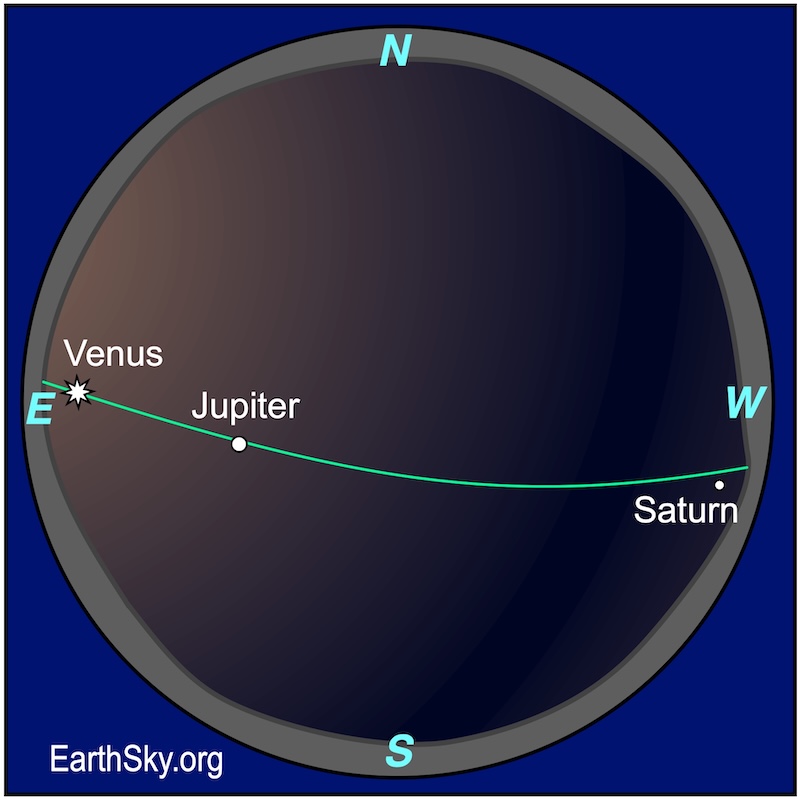 In late September, there will be 3 visible planets in the morning sky. Here’s the view from the Northern Hemisphere. You can catch Venus and Jupiter before dawn, as they continue to drift apart from their recent conjunction. And Saturn will be visible all night. The planets all lie along the ecliptic, the path the sun travels in the daytime (the green line on our chart). Chart via EarthSky.
In late September, there will be 3 visible planets in the morning sky. Here’s the view from the Northern Hemisphere. You can catch Venus and Jupiter before dawn, as they continue to drift apart from their recent conjunction. And Saturn will be visible all night. The planets all lie along the ecliptic, the path the sun travels in the daytime (the green line on our chart). Chart via EarthSky.
Late September mornings: Are Uranus and Neptune in the morning planet parade?
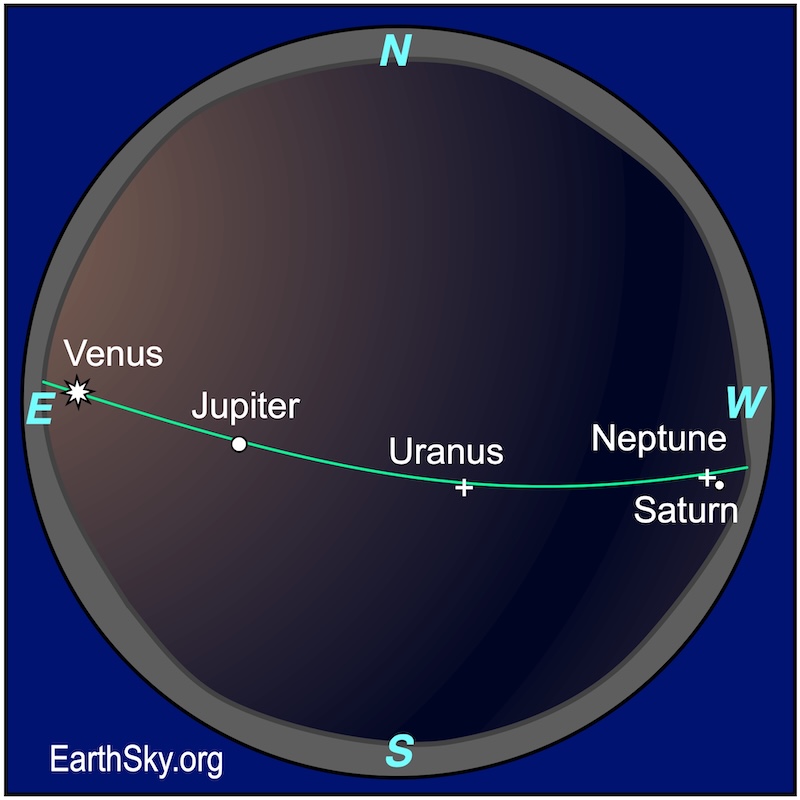 About those planet parade memes you might have seen. Yes, there are 5 planets in the morning sky. But you’ll need binoculars or a telescope to see 2 of the 5 planets. Venus, Jupiter and Saturn are easily visible to the eye alone. Uranus and Neptune are not. You’ll need dark skies, and probably at least binoculars for Uranus, and definitely a small telescope for Neptune. If you want to enjoy imagining their presence, know that Uranus lies between Venus and Saturn. And Neptune lies close to Saturn. As always, the planets lie along the ecliptic, the path the sun travels in daytime (the green line on our chart). Why? Because the planets in our solar system orbit the sun in a (mostly) flat plane. Chart via EarthSky.
About those planet parade memes you might have seen. Yes, there are 5 planets in the morning sky. But you’ll need binoculars or a telescope to see 2 of the 5 planets. Venus, Jupiter and Saturn are easily visible to the eye alone. Uranus and Neptune are not. You’ll need dark skies, and probably at least binoculars for Uranus, and definitely a small telescope for Neptune. If you want to enjoy imagining their presence, know that Uranus lies between Venus and Saturn. And Neptune lies close to Saturn. As always, the planets lie along the ecliptic, the path the sun travels in daytime (the green line on our chart). Why? Because the planets in our solar system orbit the sun in a (mostly) flat plane. Chart via EarthSky.
Our charts are mostly set for the northern half of Earth. To see a precise view – and time – from your location, try Stellarium Online.
Watch for the zodiacal light
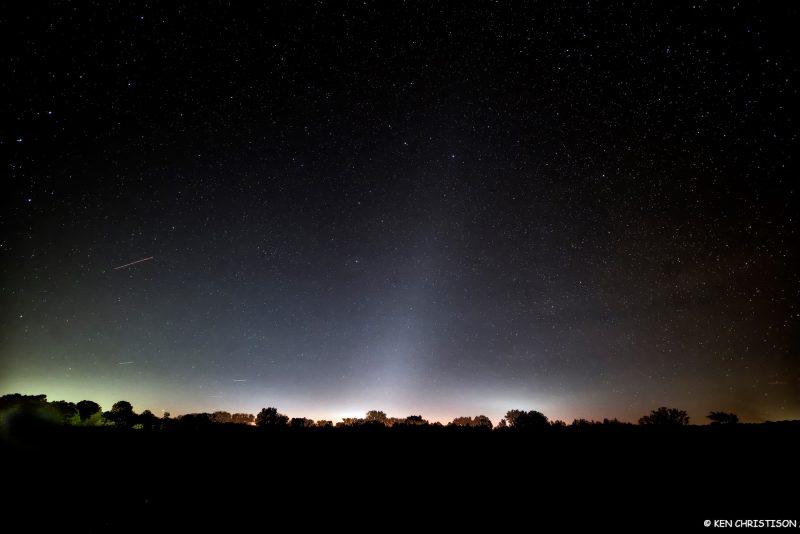 View larger. Ken Christison of North Carolina, USA, caught the zodiacal light (false dawn) on October 28, 2019, at 6:23 a.m. EDT. Because Regulus, the brightest star in the constellation Leo the Lion, sits almost exactly on the ecliptic (center line of the zodiac), the tip of this cone of light points right at the bright star Regulus. Thank you Ken! The zodiacal light may be visible before morning twilight for Northern Hemisphere observers in dark skies around the September equinox. Southern Hemisphere observers? Look for it as darkness falls.
View larger. Ken Christison of North Carolina, USA, caught the zodiacal light (false dawn) on October 28, 2019, at 6:23 a.m. EDT. Because Regulus, the brightest star in the constellation Leo the Lion, sits almost exactly on the ecliptic (center line of the zodiac), the tip of this cone of light points right at the bright star Regulus. Thank you Ken! The zodiacal light may be visible before morning twilight for Northern Hemisphere observers in dark skies around the September equinox. Southern Hemisphere observers? Look for it as darkness falls.
September 26: Moon reaches apogee
The moon will reach apogee – its farthest distance from Earth in its elliptical orbit – at 10 UTC on September 26, 2025, when it’s 251,995 miles (405,548 km) away.
September 26 and 27 evenings: Moon pairs up with Antares and Scorpius
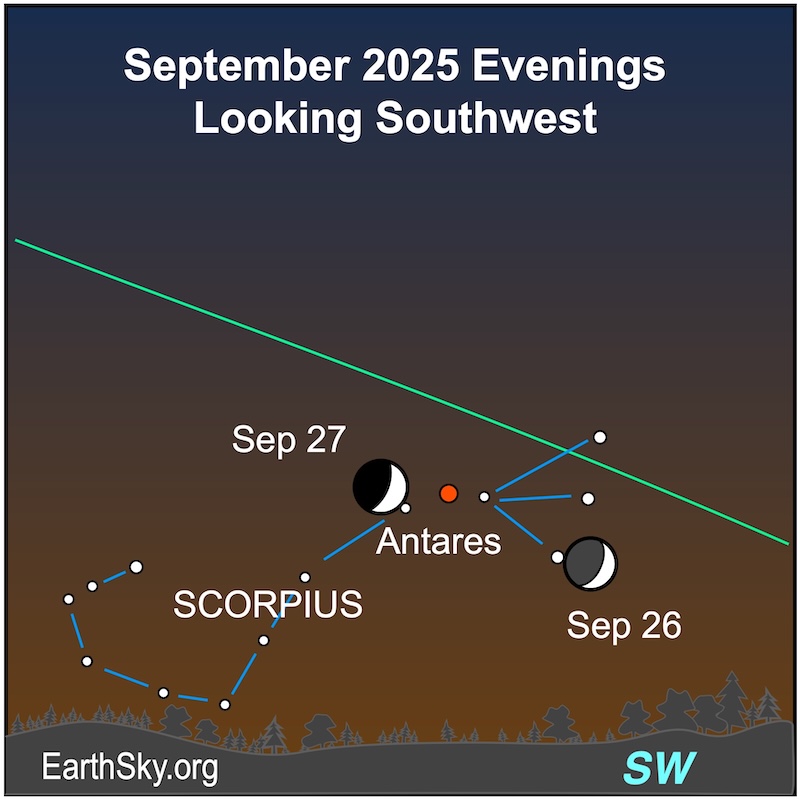 On September 26, the waxing crescent moon will begin moving through Scorpius the Scorpion. Then on the next evening, September 27, it will lie close to the brightest star in Scorpius, Antares. What’s more, a few lucky observers in parts of the Easter Islands, South America, Antarctica, Kerguelen Islands and Marion Island will see the moon occult – or pass in front of – Antares at 18 UTC on September 27. If you look outside then and don’t see Antares … that might be because it’s behind the moon! Details on the occultation here. They’ll set a few hours after sunset. Chart via EarthSky.
On September 26, the waxing crescent moon will begin moving through Scorpius the Scorpion. Then on the next evening, September 27, it will lie close to the brightest star in Scorpius, Antares. What’s more, a few lucky observers in parts of the Easter Islands, South America, Antarctica, Kerguelen Islands and Marion Island will see the moon occult – or pass in front of – Antares at 18 UTC on September 27. If you look outside then and don’t see Antares … that might be because it’s behind the moon! Details on the occultation here. They’ll set a few hours after sunset. Chart via EarthSky.
Read more: Massive ruby red Antares is the Scorpion’s Heart
Our charts are mostly set for the northern half of Earth. To see a precise view – and time – from your location, try Stellarium Online.
September 28, 29 and 30 evenings: Moon visits the Teapot
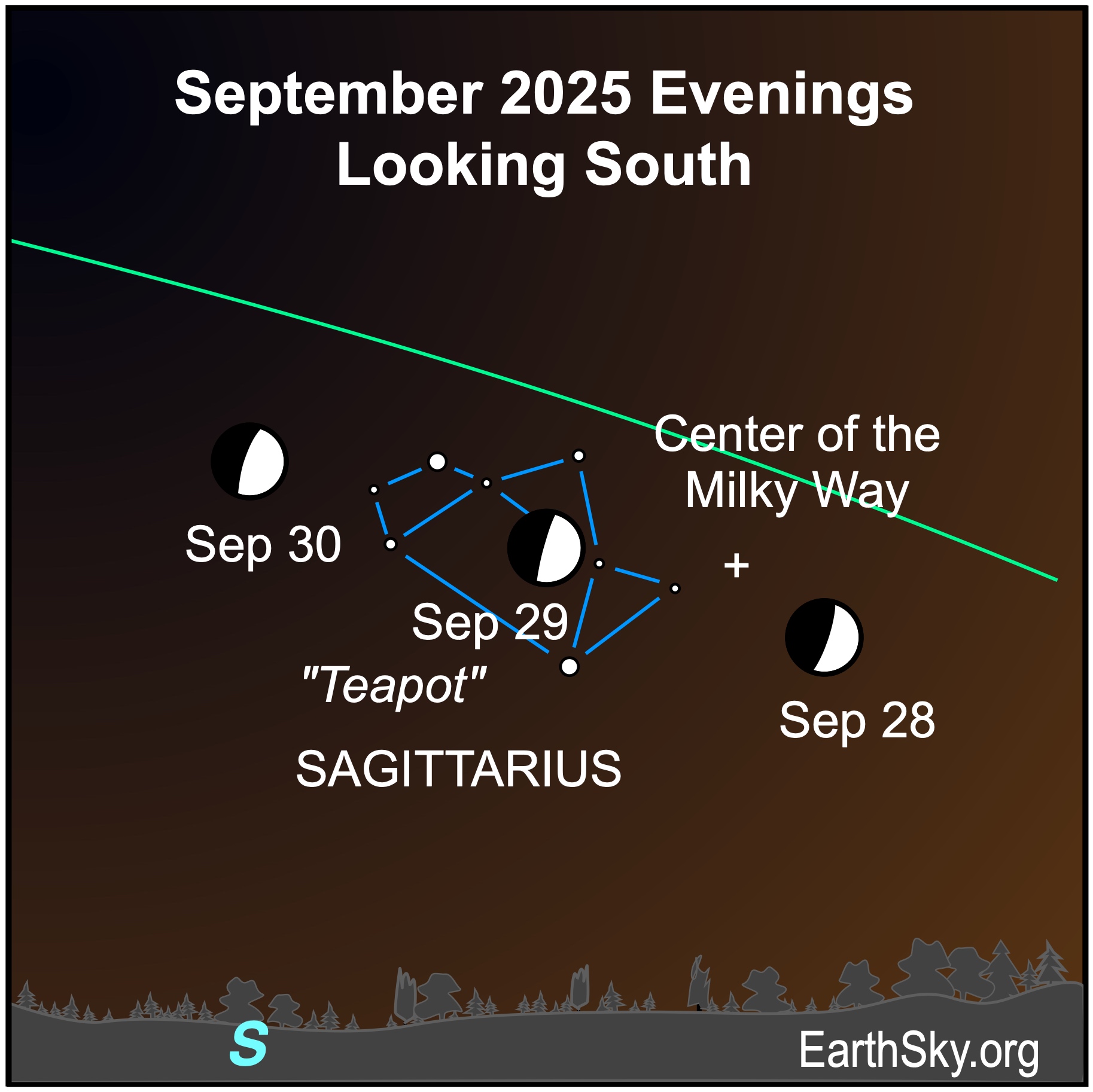 On the evening of September 28, the fat waxing crescent moon will float near the direction of the center of the Milky Way galaxy and the Teapot asterism of Sagittarius the Archer. On the following evening, September 29, the 1st quarter moon will float among the stars of the Teapot, most likely drowning them out. Then on September 30, the waxing gibbous moon will lie near the Teapot’s handle. Because the moon’s glow makes spotting the Teapot’s stars difficult, wait until it has passed on to see the Teapot shape. Chart via EarthSky.
On the evening of September 28, the fat waxing crescent moon will float near the direction of the center of the Milky Way galaxy and the Teapot asterism of Sagittarius the Archer. On the following evening, September 29, the 1st quarter moon will float among the stars of the Teapot, most likely drowning them out. Then on September 30, the waxing gibbous moon will lie near the Teapot’s handle. Because the moon’s glow makes spotting the Teapot’s stars difficult, wait until it has passed on to see the Teapot shape. Chart via EarthSky.
September 29: 1st quarter moon
The moment of 1st quarter moon will fall at 23:54 UTC on September 29, 2025. That’s 7:41 a.m. CDT. Did you know you can see an X and V on the 1st quarter moon? Here’s how to see them. A 1st quarter moon rises around noon your local time and sets around midnight. Watch for a 1st quarter moon high in the sky at sundown.
Want more? Here are 4 keys to understanding the moon’s phases.
Join EarthSky’s Marcy Curran in a video preview of the stars, constellations – and planets – for the month of September 2025. Plus, the rich Milky Way is still prominent overhead under a dark sky. Check it out!
October 1 and 2 evenings: Moon and Capricornus
 The bright waxing gibbous moon will hang in the south near the arrow-shaped constellation Capricornus the Sea-goat after sunset on October 1. On the following night, October 2, it will lie among the stars of the constellation. Chart via EarthSky.
The bright waxing gibbous moon will hang in the south near the arrow-shaped constellation Capricornus the Sea-goat after sunset on October 1. On the following night, October 2, it will lie among the stars of the constellation. Chart via EarthSky.
Read more: Capricornus the Sea-goat has an arrowhead shape
October evening planets
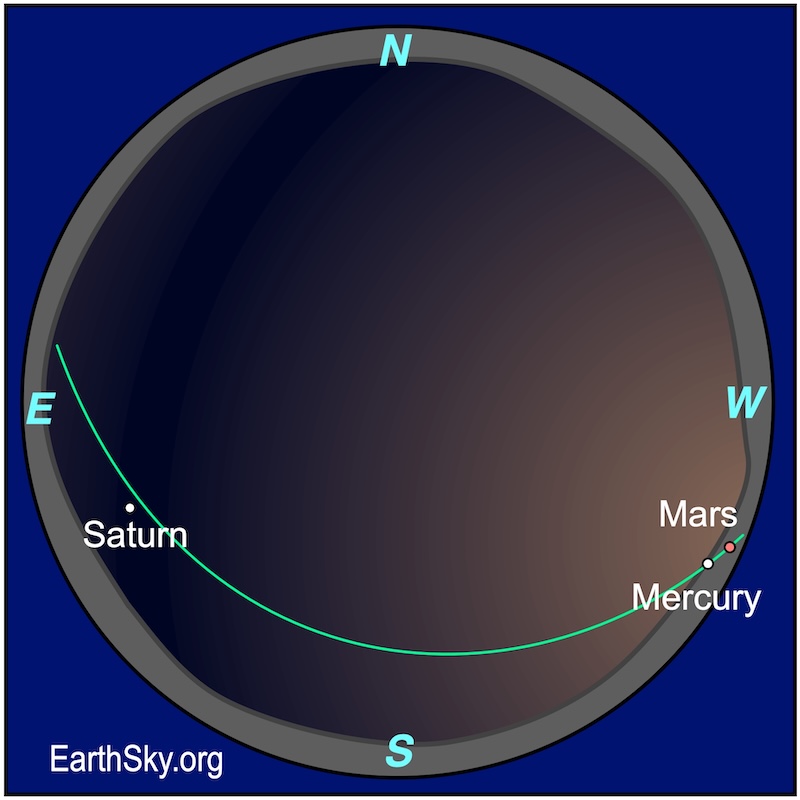 Sphere chart showing 3 planets in the October evening sky as viewed from the Northern Hemisphere: Saturn is in the southeast with Mercury and dim Mars very low in the bright southwestern twilight. Saturn is well placed for evening viewing this month, and its rings are titled 1 degree from edge-on by mid-month. Mars is increasingly difficult to spot in the evening twilight this month. Brighter Mercury joins it around mid-month and will be closest to it – about 2 degrees away – on the evenings of October 20 and 21. Plus, Mercury’s October 29 greatest evening elongation is the best evening apparition of Mercury this year for the Southern Hemisphere. The planets all lie along the path the sun travels in the daytime (the green line on our chart). Chart via EarthSky.
Sphere chart showing 3 planets in the October evening sky as viewed from the Northern Hemisphere: Saturn is in the southeast with Mercury and dim Mars very low in the bright southwestern twilight. Saturn is well placed for evening viewing this month, and its rings are titled 1 degree from edge-on by mid-month. Mars is increasingly difficult to spot in the evening twilight this month. Brighter Mercury joins it around mid-month and will be closest to it – about 2 degrees away – on the evenings of October 20 and 21. Plus, Mercury’s October 29 greatest evening elongation is the best evening apparition of Mercury this year for the Southern Hemisphere. The planets all lie along the path the sun travels in the daytime (the green line on our chart). Chart via EarthSky.
October morning planets
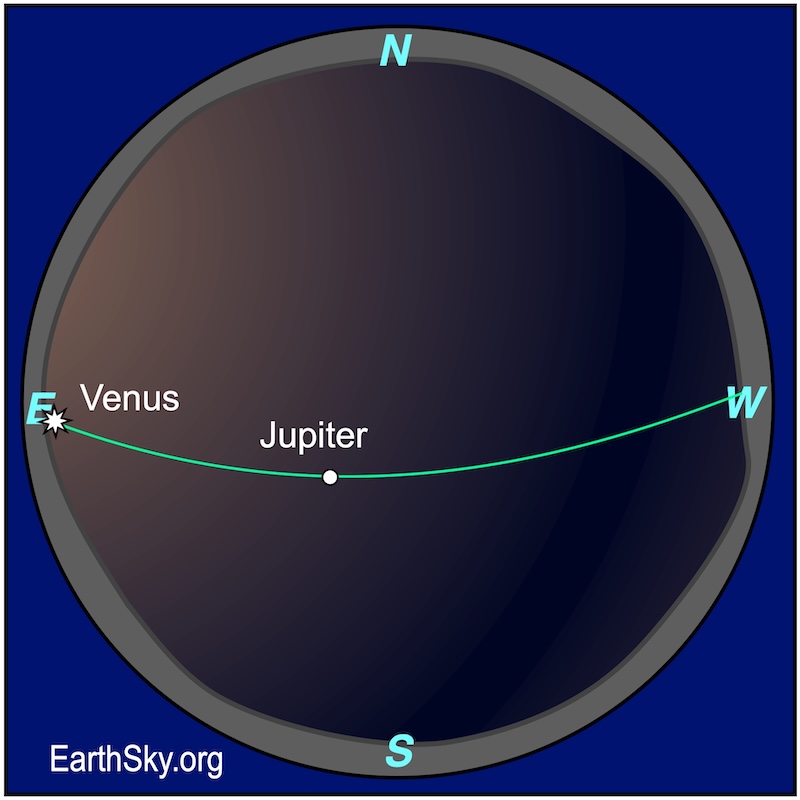 Sphere chart showing 2 bright planets in the October morning sky as viewed from the Northern Hemisphere: Venus will lie low in the east, and Jupiter will shine higher in the morning sky. Venus rises a few hours before sunrise. Jupiter rises around midnight and is high in the sky before dawn. The planets all lie along the path the sun travels in the daytime (the green line on our chart). Chart via EarthSky.
Sphere chart showing 2 bright planets in the October morning sky as viewed from the Northern Hemisphere: Venus will lie low in the east, and Jupiter will shine higher in the morning sky. Venus rises a few hours before sunrise. Jupiter rises around midnight and is high in the sky before dawn. The planets all lie along the path the sun travels in the daytime (the green line on our chart). Chart via EarthSky.
October 4 and 5 evenings: Moon, Saturn and Fomalhaut
 The bright waxing gibbous moon will approach Saturn in the southeast after sunset on October 4. Then on the following evening, October 5, it will hang close to Saturn. The bright star Fomalhaut is nearby. Chart via EarthSky.
The bright waxing gibbous moon will approach Saturn in the southeast after sunset on October 4. Then on the following evening, October 5, it will hang close to Saturn. The bright star Fomalhaut is nearby. Chart via EarthSky.
Read more: Fomalhaut is the Loneliest Star … but not in 2025
Our charts are mostly set for the northern half of Earth. To see a precise view – and time – from your location, try Stellarium Online.
October 6 all night: Full Harvest Moon and Saturn
 The crest of the full Harvest Moon occurs at 3:48 UTC on October 7 (10:48 p.m. CDT on October 6). It’ll be the 1st of 4 supermoons in a row. The moon will be visible all night and will be close to Saturn that evening. Chart via EarthSky.
The crest of the full Harvest Moon occurs at 3:48 UTC on October 7 (10:48 p.m. CDT on October 6). It’ll be the 1st of 4 supermoons in a row. The moon will be visible all night and will be close to Saturn that evening. Chart via EarthSky.
October 8: Moon reaches perigee
The moon will reach perigee – its closest point to us in its elliptical orbit around Earth – at 13 UTC on October 8, 2025, when it’s 223,581 miles (359,819 km) away.
Early October meteors … the Draconids
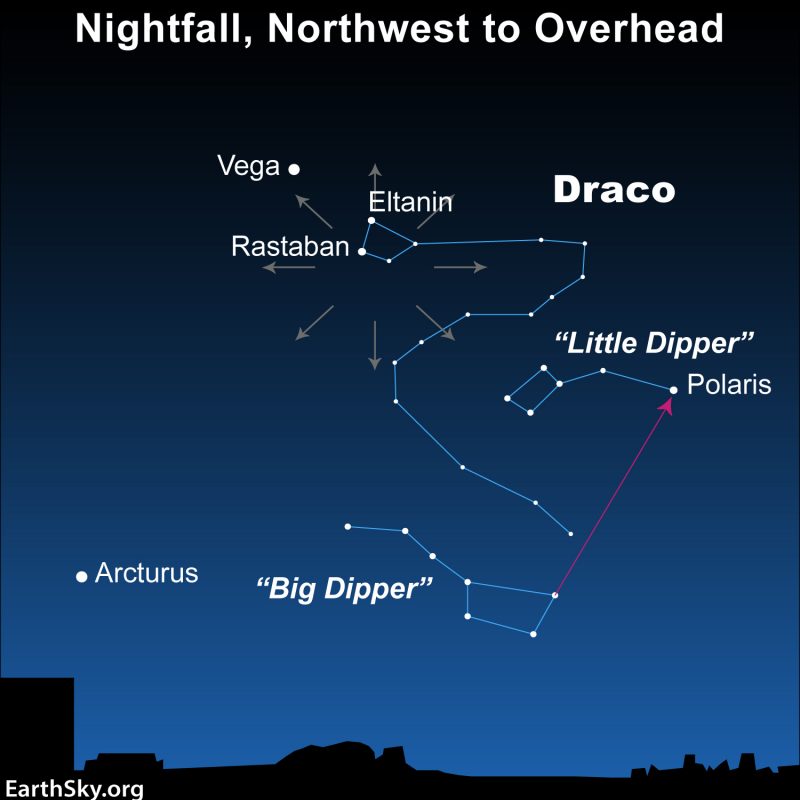 The best time to watch the Draconids in 2025 is as darkness falls on the evening of October 8 through the wee hours of the morning on October 9. However, the thick waning gibbous will light up the sky. In the moonlight, you might see only a few meteors per hour. So try to block out the moon when watching for meteors. The radiant point for the Draconid meteor shower almost coincides with the head of the constellation Draco the Dragon in the northern sky. The Northern Hemisphere has the best view of the Draconids. This chart faces northward at nightfall in October. From more southern latitudes you won’t see the Dipper at all in the evening at this time of year. But, if you can spot it low in the sky, use the Big Dipper to star-hop to the star Polaris. Polaris marks the end star in the handle of the Little Dipper. Got all these stars? Then you should also be able to spot Eltanin and Rastaban, the Draconids’ radiant point, high in the northwest sky at nightfall in early October. Draconid meteors radiate from near these stars, which are known as the Dragon’s Eyes.
The best time to watch the Draconids in 2025 is as darkness falls on the evening of October 8 through the wee hours of the morning on October 9. However, the thick waning gibbous will light up the sky. In the moonlight, you might see only a few meteors per hour. So try to block out the moon when watching for meteors. The radiant point for the Draconid meteor shower almost coincides with the head of the constellation Draco the Dragon in the northern sky. The Northern Hemisphere has the best view of the Draconids. This chart faces northward at nightfall in October. From more southern latitudes you won’t see the Dipper at all in the evening at this time of year. But, if you can spot it low in the sky, use the Big Dipper to star-hop to the star Polaris. Polaris marks the end star in the handle of the Little Dipper. Got all these stars? Then you should also be able to spot Eltanin and Rastaban, the Draconids’ radiant point, high in the northwest sky at nightfall in early October. Draconid meteors radiate from near these stars, which are known as the Dragon’s Eyes.
Read more: All you need to know about Draconid meteors
October 8 and 9 evenings: Moon and Pleiades
 In the late evening of October 8, the waning gibbous moon will lie near the Pleiades star cluster. Then on the next evening, October 9, it will pass next to and occult – or pass in front of – some of the stars of the Pleiades. Aldebaran, the fiery eye of Taurus the Bull, is nearby. Chart via EarthSky.
In the late evening of October 8, the waning gibbous moon will lie near the Pleiades star cluster. Then on the next evening, October 9, it will pass next to and occult – or pass in front of – some of the stars of the Pleiades. Aldebaran, the fiery eye of Taurus the Bull, is nearby. Chart via EarthSky.
Read more: The Pleiades – or 7 Sisters – known around the world
October 9 evening: Moon blots out some Pleiades
 Here’s a binocular view of the waning gibbous moon passing slowly in front of the stars of the Pleiades on October 9. Chart via EarthSky.
Here’s a binocular view of the waning gibbous moon passing slowly in front of the stars of the Pleiades on October 9. Chart via EarthSky.
October 10 evening: Moon, Pleiades and 2 bright stars
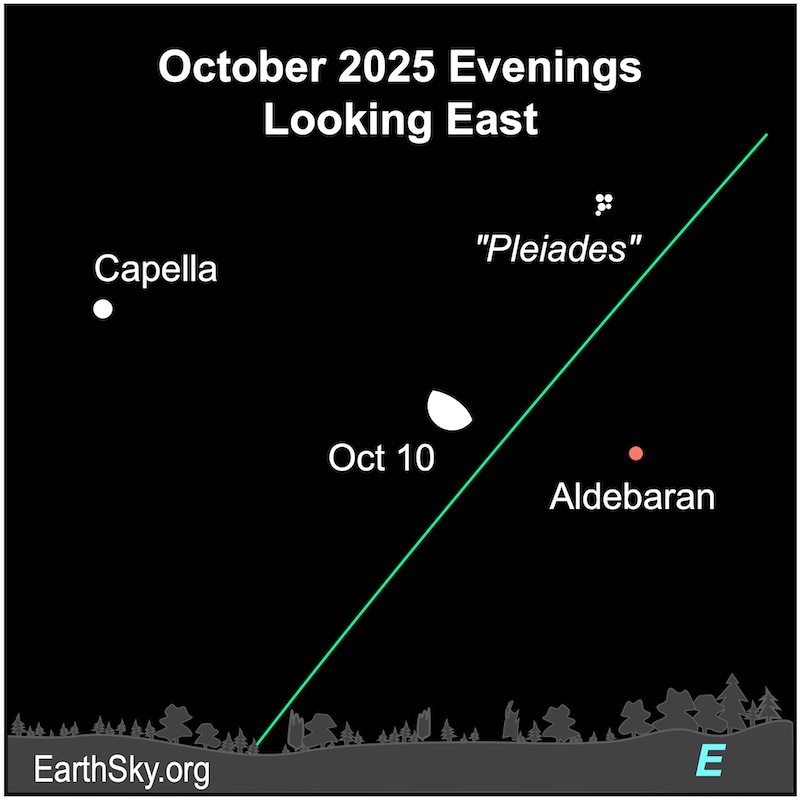 The waning gibbous moon will float between orangish Aldebaran and golden Capella on the evening of October 10. The Pleiades star cluster is nearby. Chart via EarthSky.
The waning gibbous moon will float between orangish Aldebaran and golden Capella on the evening of October 10. The Pleiades star cluster is nearby. Chart via EarthSky.
Read more: Capella is sometimes called the Goat Star
October 11 morning: Moon, Capella, Betelgeuse and Aldebaran
 On the morning of October 12, the waning gibbous moon will lie between Betelgeuse and Capella with Aldebaran nearby. Chart via EarthSky.
On the morning of October 12, the waning gibbous moon will lie between Betelgeuse and Capella with Aldebaran nearby. Chart via EarthSky.
Read more: Companion for Betelgeuse confirmed! Beloved red star has a blue-white buddy
Our charts are mostly set for the northern half of Earth. To see a precise view – and time – from your location, try Stellarium Online.
October 13: Watch for the 3rd quarter moon
The moment of last quarter moon will fall at 18:13 UTC on September 14, 2025. That’s 1:13 p.m. CDT. It’ll rise after midnight your local time and set around noon. Look for it high in the sky before dawn.
Want more? Here are 4 keys to understanding the moon’s phases.
October 13 and 14 mornings: Moon, Jupiter and twin stars
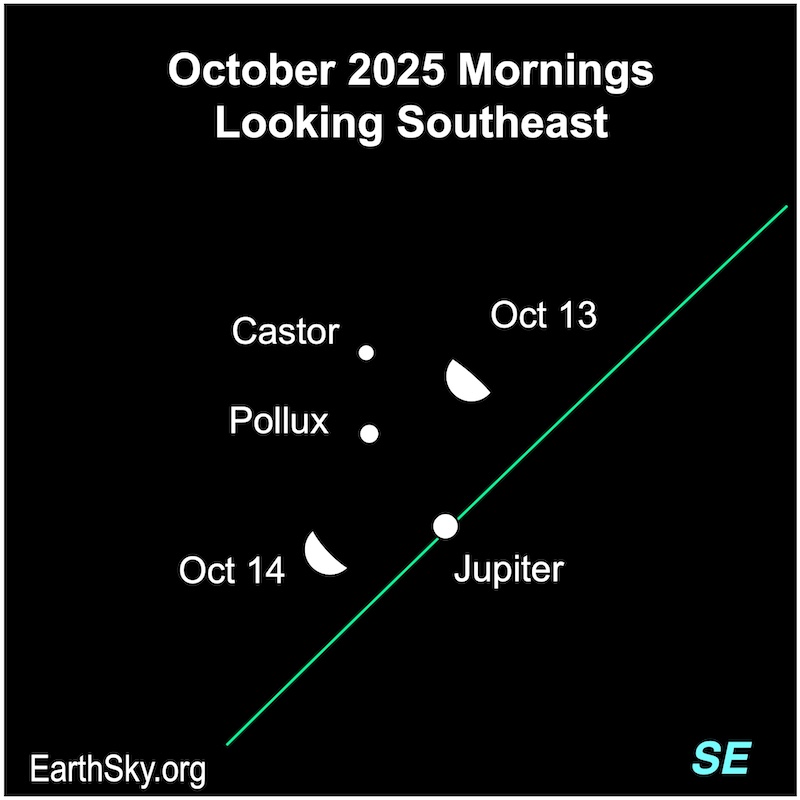 On the morning of October 13, the 3rd quarter moon will lie near bright Jupiter and the twin stars of Gemini, Castor and Pollux. On the next morning, the waning crescent moon floats the trio in the morning sky. Chart via EarthSky.
On the morning of October 13, the 3rd quarter moon will lie near bright Jupiter and the twin stars of Gemini, Castor and Pollux. On the next morning, the waning crescent moon floats the trio in the morning sky. Chart via EarthSky.
October 15 and 16 mornings: Moon, Regulus and the Beehive
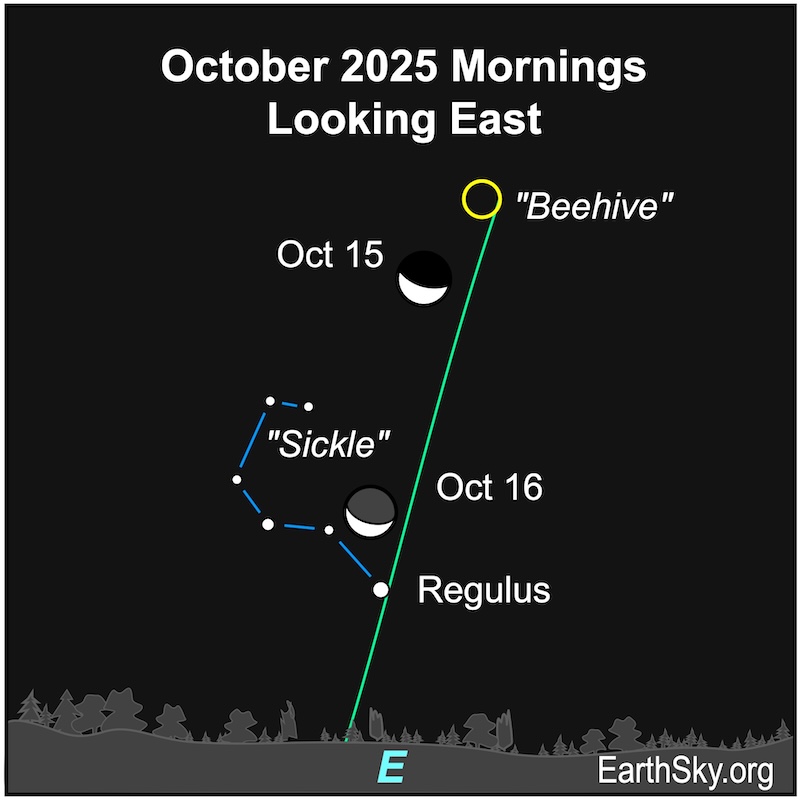 On the morning of October 15, the fat waning crescent moon will stand high in the east above Regulus, and below the Beehive star cluster. Then on October 16, the moon will be close to Regulus, the brightest star in Leo the Lion that marks the period in the backward question mark known as the Sickle. Chart via EarthSky.
On the morning of October 15, the fat waning crescent moon will stand high in the east above Regulus, and below the Beehive star cluster. Then on October 16, the moon will be close to Regulus, the brightest star in Leo the Lion that marks the period in the backward question mark known as the Sickle. Chart via EarthSky.
Read more: The Beehive cluster: A swarm of 1,000 stars
October 17 and 18 mornings: Moon and Regulus
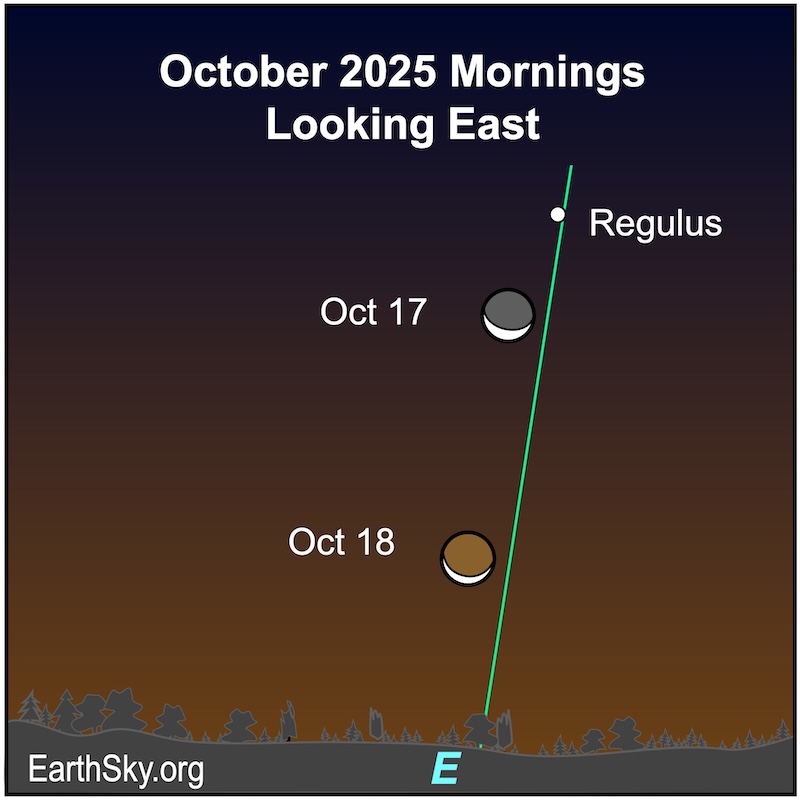 On the morning of October 17, the waning crescent moon will shine near the bright star Regulus, the brightest star in Leo the Lion. On the next morning, October 18, a thinner crescent moon will float between Regulus and the eastern horizon. Chart via EarthSky.
On the morning of October 17, the waning crescent moon will shine near the bright star Regulus, the brightest star in Leo the Lion. On the next morning, October 18, a thinner crescent moon will float between Regulus and the eastern horizon. Chart via EarthSky.
Read more: Meet Regulus, Leo the Lion’s Heart and brightest star
Watch for the zodiacal light
 View larger. Ken Christison of North Carolina, USA, caught the zodiacal light (false dawn) on October 28, 2019, at 6:23 a.m. EDT. Thank you Ken! The zodiacal light might be visible before morning twilight for Northern Hemisphere observers in dark skies around the September equinox. Southern Hemisphere observers? Look for it as darkness falls.
View larger. Ken Christison of North Carolina, USA, caught the zodiacal light (false dawn) on October 28, 2019, at 6:23 a.m. EDT. Thank you Ken! The zodiacal light might be visible before morning twilight for Northern Hemisphere observers in dark skies around the September equinox. Southern Hemisphere observers? Look for it as darkness falls.
October 19 and 20 mornings: Moon and Venus
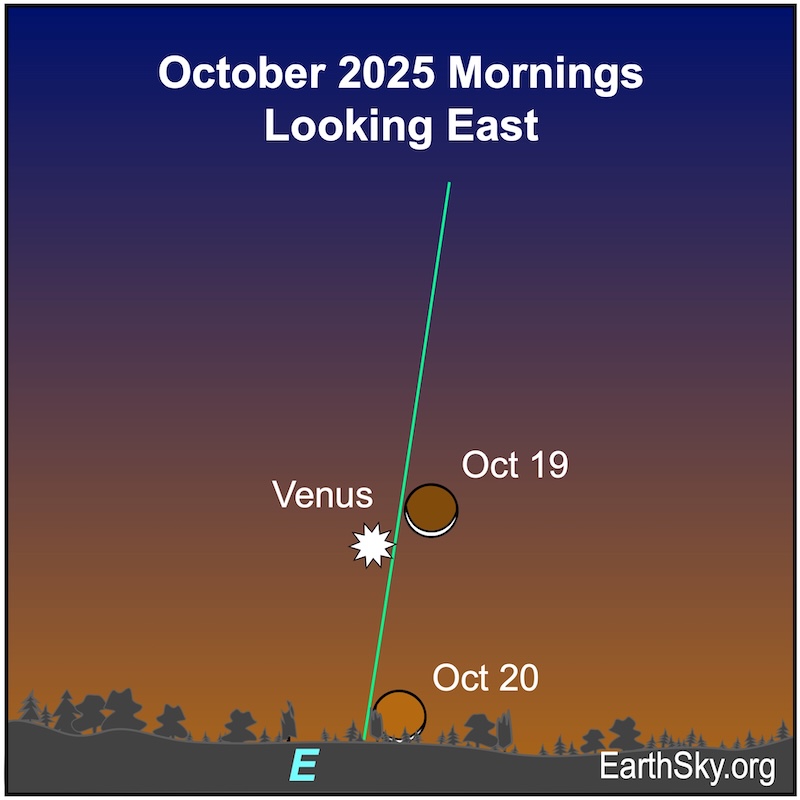 On the morning of October 19, the thin waning crescent moon will hang close to Venus. The next morning, October 20, the slender crescent moon will lie near the horizon shortly before sunrise. Do you notice a lovely glow on the unlit side of the moon? That’s earthshine! It’s reflected light from Earth. Chart via EarthSky.
On the morning of October 19, the thin waning crescent moon will hang close to Venus. The next morning, October 20, the slender crescent moon will lie near the horizon shortly before sunrise. Do you notice a lovely glow on the unlit side of the moon? That’s earthshine! It’s reflected light from Earth. Chart via EarthSky.
October 21: New moon and perfect timing for the Orionid meteor shower
The moment of new moon will fall at 12:25 UTC on October 21, 2025. That’s 7:25 a.m. CDT. New moons rise and set with the sun. Nights around the new moon are perfect for stargazing, and this one coincides with the peak of the Oroinid meteor shower. See EarthSky’s best places to stargaze.
Want more? Here are 4 keys to understanding the moon’s phases.
October 21: Orionid meteor shower
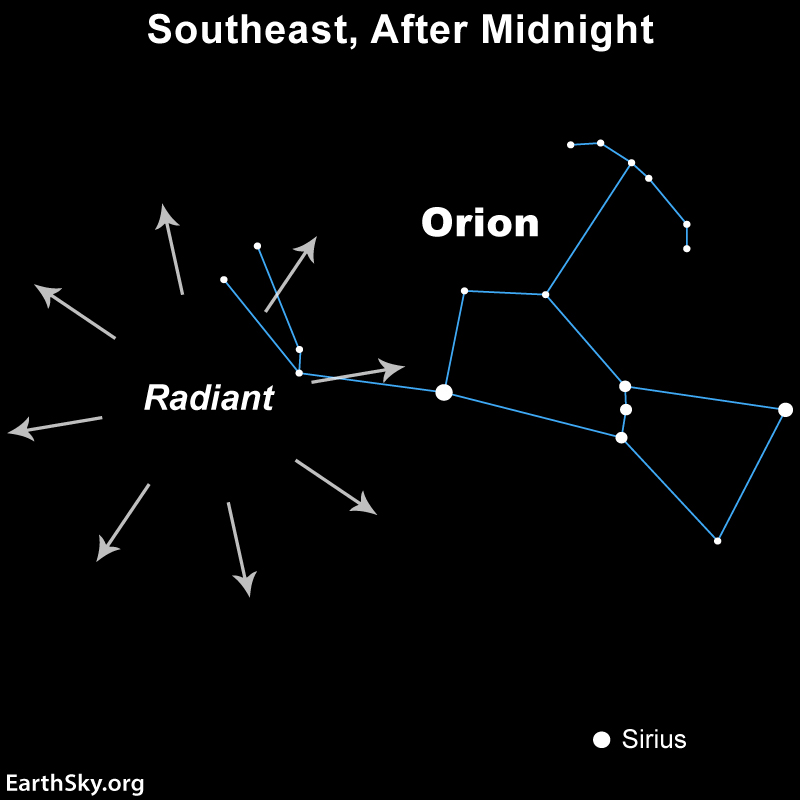 Watch for Orionid meteors on the morning of October 21, starting after midnight through the wee hours before dawn. If you trace Orionid meteors backward on the sky’s dome, they seem to radiate from the upraised club of the famous constellation Orion the Hunter. This is the shower’s radiant point. The bright star near the radiant point is reddish Betelgeuse. Under a dark sky with no moon, the Orionids exhibit a maximum of about 10 to 20 meteors per hour. Chart via EarthSky.
Watch for Orionid meteors on the morning of October 21, starting after midnight through the wee hours before dawn. If you trace Orionid meteors backward on the sky’s dome, they seem to radiate from the upraised club of the famous constellation Orion the Hunter. This is the shower’s radiant point. The bright star near the radiant point is reddish Betelgeuse. Under a dark sky with no moon, the Orionids exhibit a maximum of about 10 to 20 meteors per hour. Chart via EarthSky.
Read more: Everything you need to know Orionid meteors
October 24: Moon reaches apogee
The moon will reach apogee – its farthest distance from Earth in its elliptical orbit – at 0 UTC on October 24, 2025, when it’s 252,552 miles (406,444 km) away.
October 24 and 25 evenings: Moon and Antares
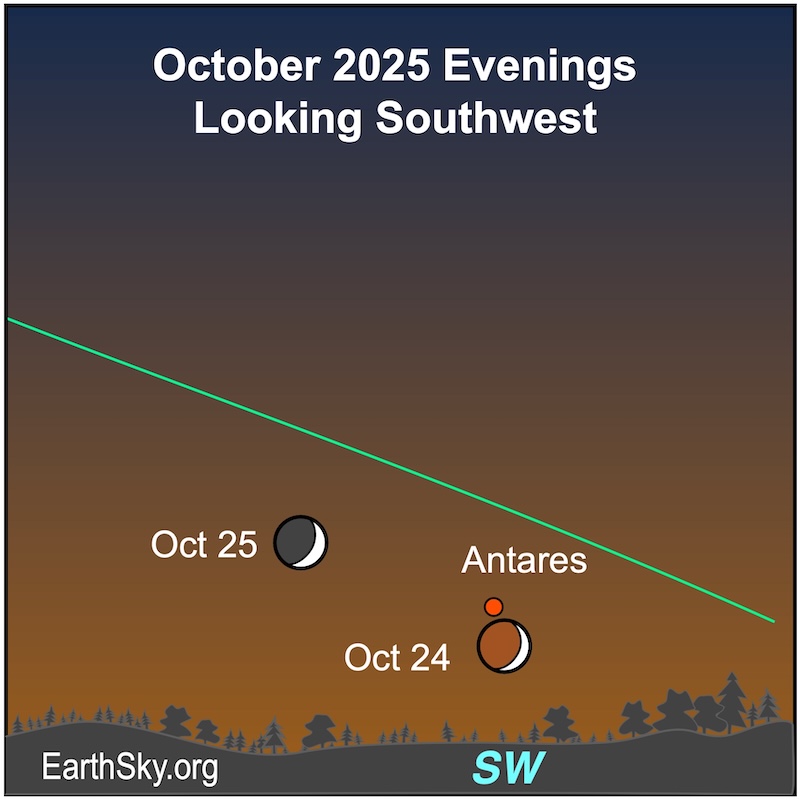 Shortly after sunset on October 24, the thin waxing crescent moon will hang next to Antares just above the horizon. Do you notice a lovely glow on the unlit side of the moon? That’s earthshine! It’s reflected light from Earth. The next evening, October 25, the crescent moon will move away from Antares and hang higher in the sky. Chart via EarthSky.
Shortly after sunset on October 24, the thin waxing crescent moon will hang next to Antares just above the horizon. Do you notice a lovely glow on the unlit side of the moon? That’s earthshine! It’s reflected light from Earth. The next evening, October 25, the crescent moon will move away from Antares and hang higher in the sky. Chart via EarthSky.
Read more: Massive ruby red Antares is the Scorpion’s Heart
Our charts are mostly set for the northern half of Earth. To see a precise view – and time – from your location, try Stellarium Online.
October 26 and 27 evenings: Moon and Teapot
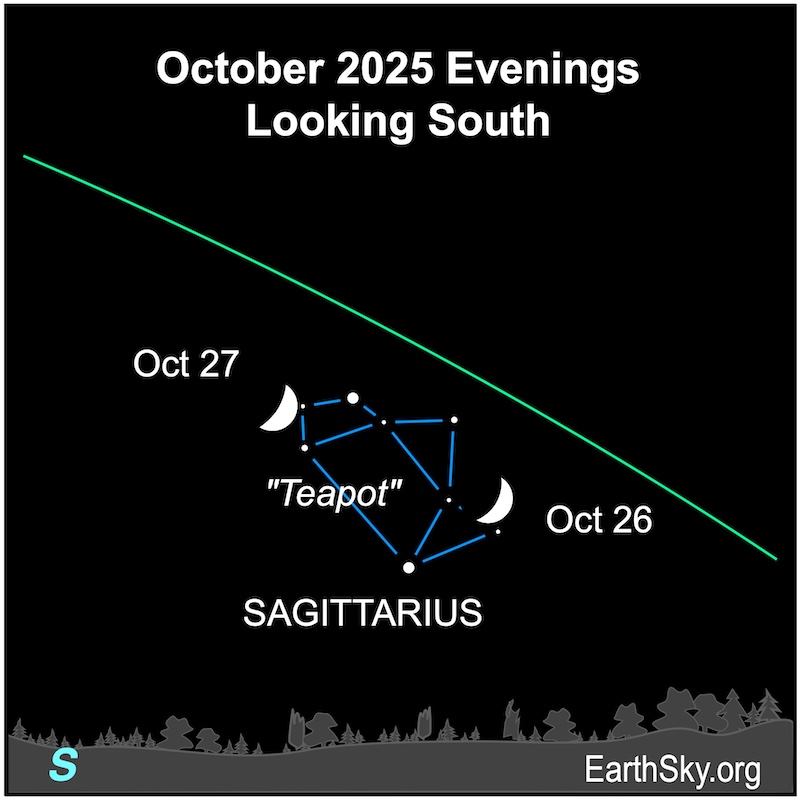 On the evenings of October 26 and 27, the thickening waxing crescent moon will move through the Teapot asterism of Sagittarius. Chart via EarthSky.
On the evenings of October 26 and 27, the thickening waxing crescent moon will move through the Teapot asterism of Sagittarius. Chart via EarthSky.
Read more: Teapot of Sagittarius points to Milky Way Center
October 29: 1st quarter moon
The moment of 1st quarter moon will fall at 16:21 UTC on September 29, 2025. That’s 11:21 a.m. CDT. Did you know you can see an X and V on the 1st quarter moon? Here’s how to see them. A 1st quarter moon rises around noon your local time and sets around midnight. Watch for a 1st quarter moon high in the sky at sundown.
Want more? Here are 4 keys to understanding the moon’s phases.
October 29: Mercury reaches greatest elongation from evening sun
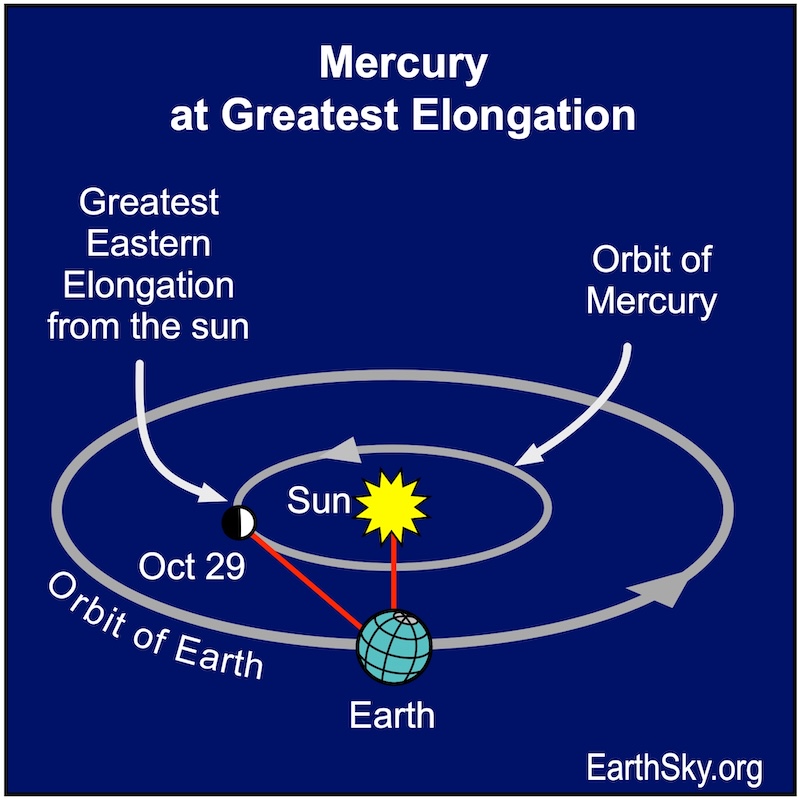 Mercury will make its widest angle from the sun in the western sky on October 29. This point in its orbit is called greatest eastern elongation. Chart via EarthSky.
Mercury will make its widest angle from the sun in the western sky on October 29. This point in its orbit is called greatest eastern elongation. Chart via EarthSky.
Read more: Mercury is farthest from the sunset on October 29
October 29 and 30 evenings: Moon and Capricornus
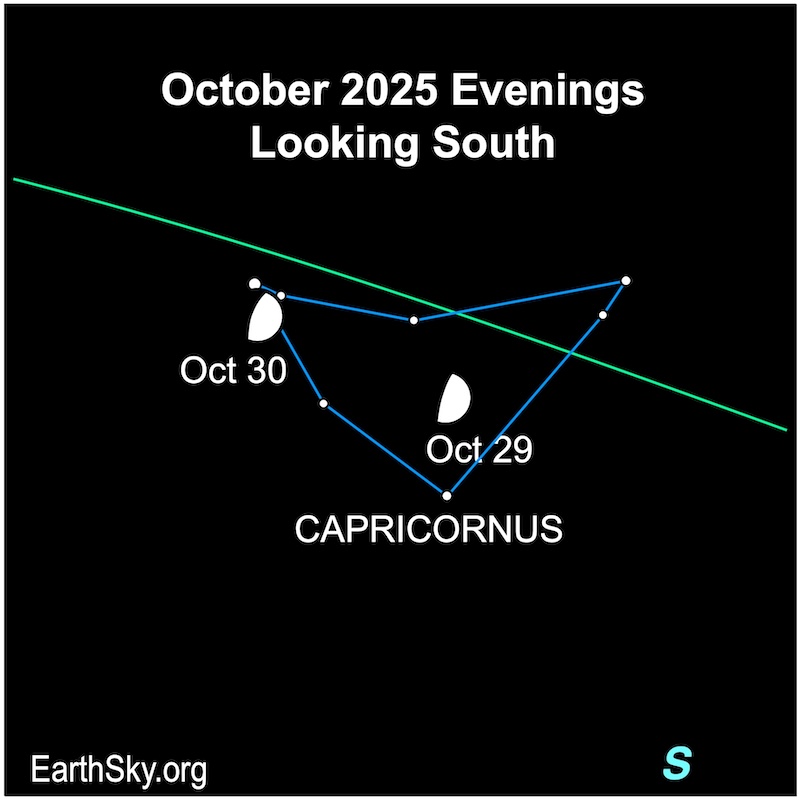 On the evening of October 29, the 1st quarter moon will lie in the center of Capricornus the Sea-goat. Then on the next evening, October 30, the waxing gibbous moon will move away from the arrow-shaped pattern of stars of Capricornus. Chart via EarthSky.
On the evening of October 29, the 1st quarter moon will lie in the center of Capricornus the Sea-goat. Then on the next evening, October 30, the waxing gibbous moon will move away from the arrow-shaped pattern of stars of Capricornus. Chart via EarthSky.
Read more: Capricornus the Sea-goat has an arrowhead shape
October 31 evening: Moon, Saturn and Fomalhaut
 On the last evening of October – on Halloween – the waxing gibbous moon will float near Saturn and the star Fomalhaut. Chart via EarthSky.
On the last evening of October – on Halloween – the waxing gibbous moon will float near Saturn and the star Fomalhaut. Chart via EarthSky.
Read more: Fomalhaut is the Loneliest Star … but not in 2025
Our charts are mostly set for the northern half of Earth. To see a precise view – and time – from your location, try Stellarium Online.
September stars
If you’re out stargazing on any September evening, look for these stars and constellations overhead in the evening sky.
 Any late summer evening and throughout northern autumn, you can find Cassiopeia the Queen high in the northeast sky. The shape of this constellation makes Cassiopeia’s stars very noticeable. Cassiopeia looks like the letter W (or M). She’ll be higher up in the northeast as autumn unfolds. If you have a dark sky, look below Cassiopeia for a famous binocular object. This object is called the Double Cluster in Perseus.
Any late summer evening and throughout northern autumn, you can find Cassiopeia the Queen high in the northeast sky. The shape of this constellation makes Cassiopeia’s stars very noticeable. Cassiopeia looks like the letter W (or M). She’ll be higher up in the northeast as autumn unfolds. If you have a dark sky, look below Cassiopeia for a famous binocular object. This object is called the Double Cluster in Perseus.
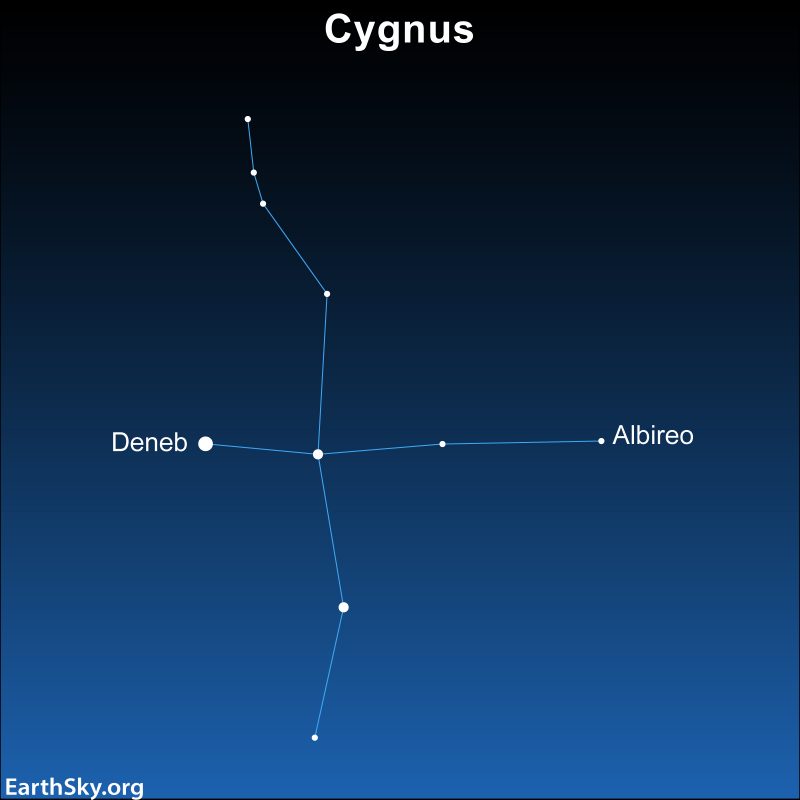 Cygnus is high overhead in the September evening sky. If you have a dark sky, it’s easy to observe the edgewise view into our own galaxy – our Milky Way – spanning across the heavens. Need help finding it? Look toward the constellation Cygnus the Swan. You might know this constellation by its asterism, the Northern Cross. The Swan swims along the Milky Way. Its brightest star is Deneb, the Swan’s Tail. Additionally, the constellation Cygnus contains one of the most beloved double stars in the sky, Albireo, which appears blue and gold.
Cygnus is high overhead in the September evening sky. If you have a dark sky, it’s easy to observe the edgewise view into our own galaxy – our Milky Way – spanning across the heavens. Need help finding it? Look toward the constellation Cygnus the Swan. You might know this constellation by its asterism, the Northern Cross. The Swan swims along the Milky Way. Its brightest star is Deneb, the Swan’s Tail. Additionally, the constellation Cygnus contains one of the most beloved double stars in the sky, Albireo, which appears blue and gold.
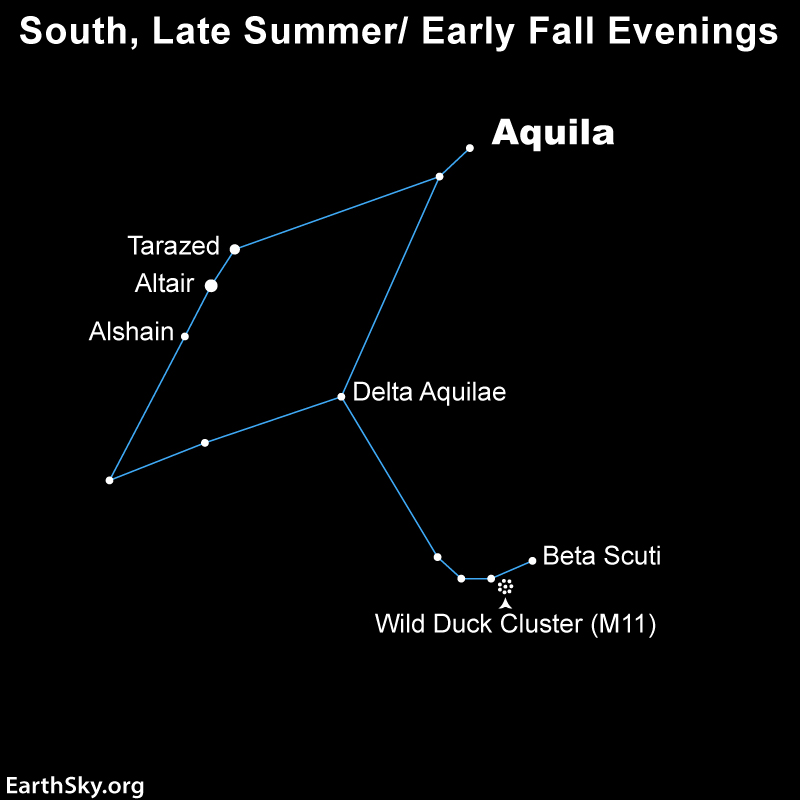 Aquila the Eagle is home to the star Altair, which is one of the corners of the Summer Triangle. The best time to see Aquila in the evening sky is from July to November as it soars along the Milky Way. And, because our galaxy provides a starry backdrop, many clusters and nebulae lie within its borders. Image via EarthSky.
Aquila the Eagle is home to the star Altair, which is one of the corners of the Summer Triangle. The best time to see Aquila in the evening sky is from July to November as it soars along the Milky Way. And, because our galaxy provides a starry backdrop, many clusters and nebulae lie within its borders. Image via EarthSky.
Our charts are mostly set for the northern half of Earth. To see a precise view – and time – from your location, try Stellarium Online.
October stars and constellations
If you’re out stargazing on any October evening, look for these stars and constellations high in the evening sky while facing north.
 You can find Cassiopeia the Queen high in the northeast during the month of October. If you have a dark sky, look below Cassiopeia for a famous binocular object. This object is called the Double Cluster in Perseus. Chart via EarthSky.
You can find Cassiopeia the Queen high in the northeast during the month of October. If you have a dark sky, look below Cassiopeia for a famous binocular object. This object is called the Double Cluster in Perseus. Chart via EarthSky.
 The house-shaped constellation Cepheus the King lies in the northern sky by the constellation Cassiopeia. Gamma Cephei, or Errai marks the peak of the roof of the house. And Errai is very near Polaris, the North Star.
The house-shaped constellation Cepheus the King lies in the northern sky by the constellation Cassiopeia. Gamma Cephei, or Errai marks the peak of the roof of the house. And Errai is very near Polaris, the North Star.
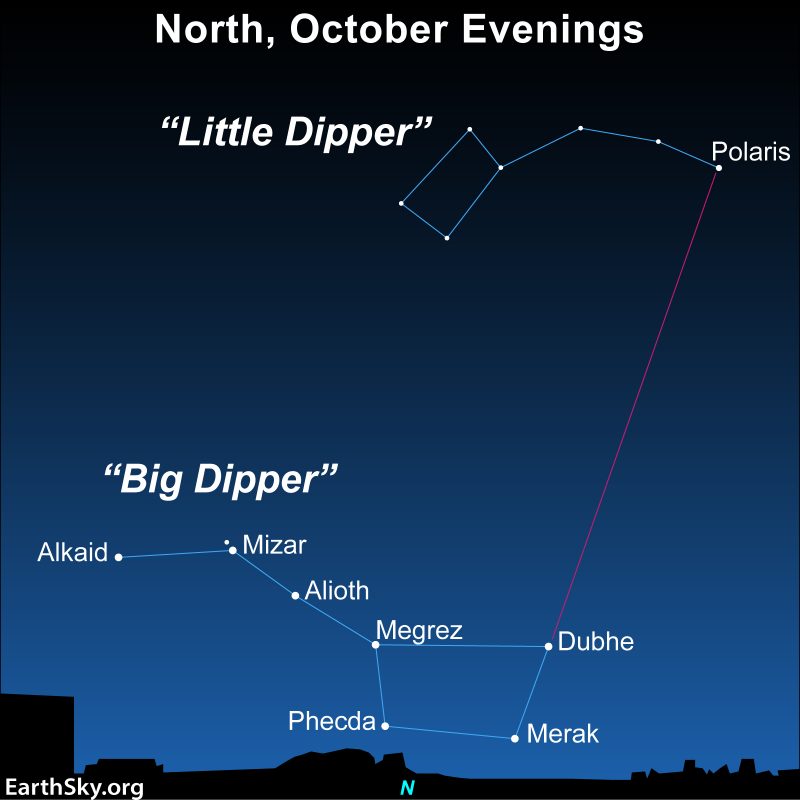 Although the Big Dipper is low on the horizon – or below the horizon – for mid-northern latitudes now, the Little Dipper is high in the northern sky. In fact, the Big Dipper is tough to spot on late October evenings because it rides so low in the north. As always, the 2 outer stars in the Dipper’s bowl point to Polaris, the North Star.
Although the Big Dipper is low on the horizon – or below the horizon – for mid-northern latitudes now, the Little Dipper is high in the northern sky. In fact, the Big Dipper is tough to spot on late October evenings because it rides so low in the north. As always, the 2 outer stars in the Dipper’s bowl point to Polaris, the North Star.
September evening planets
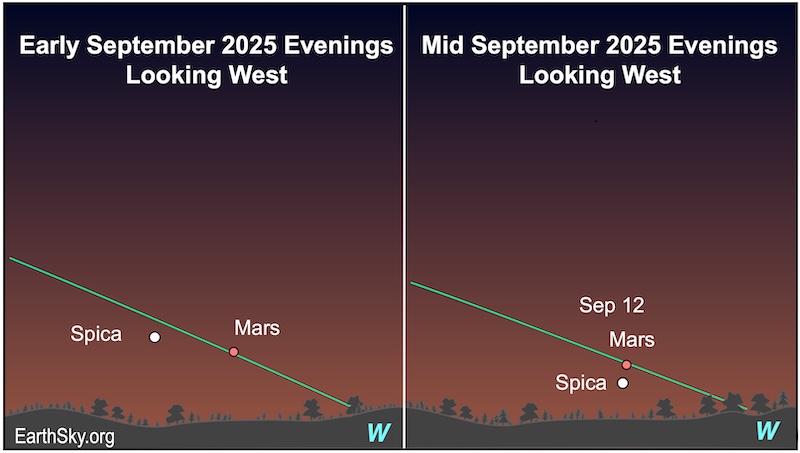 In the 1st week of September, Mars will lie low in the west and near Spica, the brightest star in Virgo the Maiden. You’ll need a clear western horizon to spot them in the evening twilight. Then on September 12, Mars will line up with Spica, which currently shines much brighter than the red planet. After mid-month, Mars will become more difficult to spot low on the western horizon. Mars will be descending more each night this month, setting with the sun by month’s end. Earth is speeding ahead of Mars now in its orbit around the sun. As a result, the distance between us and Mars is increasing, and Mars will shine at 1.6 magnitude all month. Chart via EarthSky.
In the 1st week of September, Mars will lie low in the west and near Spica, the brightest star in Virgo the Maiden. You’ll need a clear western horizon to spot them in the evening twilight. Then on September 12, Mars will line up with Spica, which currently shines much brighter than the red planet. After mid-month, Mars will become more difficult to spot low on the western horizon. Mars will be descending more each night this month, setting with the sun by month’s end. Earth is speeding ahead of Mars now in its orbit around the sun. As a result, the distance between us and Mars is increasing, and Mars will shine at 1.6 magnitude all month. Chart via EarthSky.
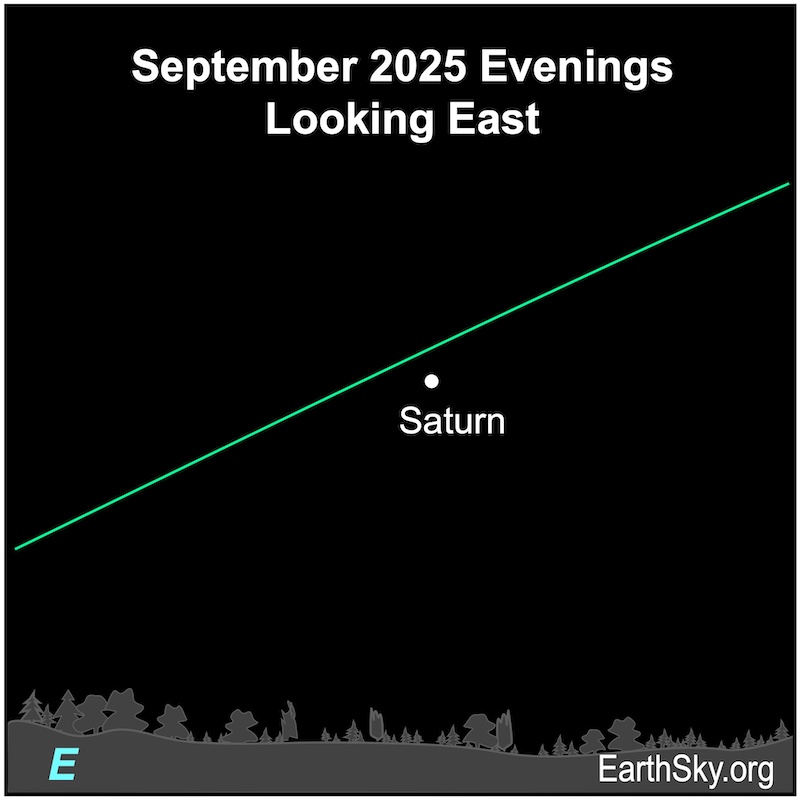 You can spot Saturn in the east in the evening hours of September. It will reach opposition — when Earth flies between Saturn and the sun — at 6 UTC on September 21. Saturn is rising in the east at sunset and is visible all night. Saturn will shine at 0.6 magnitude around opposition. It’s among the stars of Pisces the Fish most of the month. Afterward, for the rest of 2025, Saturn will remain visible in the evening sky. It’ll finally disappear in the sunset glare in February 2025. Chart via EarthSky.
You can spot Saturn in the east in the evening hours of September. It will reach opposition — when Earth flies between Saturn and the sun — at 6 UTC on September 21. Saturn is rising in the east at sunset and is visible all night. Saturn will shine at 0.6 magnitude around opposition. It’s among the stars of Pisces the Fish most of the month. Afterward, for the rest of 2025, Saturn will remain visible in the evening sky. It’ll finally disappear in the sunset glare in February 2025. Chart via EarthSky.
Our charts are mostly set for the northern half of Earth. To see a precise view – and time – from your location, try Stellarium Online.
September morning planets
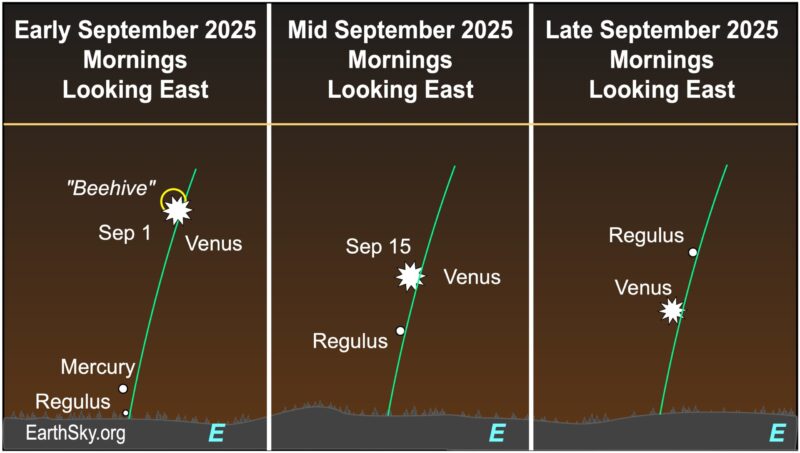 On the morning of September 1, brilliant Venus will lie next to the Beehive star cluster. Below them and close to the horizon are Mercury and Regulus. Mercury will be the brighter of the 2, and it’ll slip away at the beginning of the month. As the month goes by, Venus will move closer to the horizon, while Regulus will ascend. In the middle of the month, Venus nears Regulus, passing it on September 19. After that, the 2 will move apart with Regulus climbing higher and Venus sinking closer to the horizon. Venus will float among the stars of Gemini the Twins and move in front of Leo the Lion later in the month. By the end of the month, it’ll rise close to the sunrise and only be visible in morning twilight, shining at -3.9 magnitude. Chart via EarthSky.
On the morning of September 1, brilliant Venus will lie next to the Beehive star cluster. Below them and close to the horizon are Mercury and Regulus. Mercury will be the brighter of the 2, and it’ll slip away at the beginning of the month. As the month goes by, Venus will move closer to the horizon, while Regulus will ascend. In the middle of the month, Venus nears Regulus, passing it on September 19. After that, the 2 will move apart with Regulus climbing higher and Venus sinking closer to the horizon. Venus will float among the stars of Gemini the Twins and move in front of Leo the Lion later in the month. By the end of the month, it’ll rise close to the sunrise and only be visible in morning twilight, shining at -3.9 magnitude. Chart via EarthSky.
 In the month of September, Jupiter will shine in the east before sunrise and become more prominent the higher it climbs in the sky before sunrise. Jupiter will shine at -2 magnitude by the end of the month. It’ll be near the twin stars of Gemini: Castor and Pollux. The bright star Procyon is nearby. Chart via EarthSky.
In the month of September, Jupiter will shine in the east before sunrise and become more prominent the higher it climbs in the sky before sunrise. Jupiter will shine at -2 magnitude by the end of the month. It’ll be near the twin stars of Gemini: Castor and Pollux. The bright star Procyon is nearby. Chart via EarthSky.
Where’s Mercury? It’s too close to the sun to see this month. It’ll reappear low in the evening sky in October.
October evening planets
 During late October, viewers in the Northern Hemisphere can look for Mercury low in the bright southwestern twilight about 30 minutes after sunset. The little planet will be difficult to spot. It’ll reach its greatest elongations from the evening sun on October 29. Southern Hemisphere observers can spot it through mid-November. Mercury moves through the constellations of Virgo the Maiden to Libra the Scales to Scorpius the Scorpion this month. Chart via EarthSky.
During late October, viewers in the Northern Hemisphere can look for Mercury low in the bright southwestern twilight about 30 minutes after sunset. The little planet will be difficult to spot. It’ll reach its greatest elongations from the evening sun on October 29. Southern Hemisphere observers can spot it through mid-November. Mercury moves through the constellations of Virgo the Maiden to Libra the Scales to Scorpius the Scorpion this month. Chart via EarthSky.
 About 30 minutes after sunset, Mars will lie very low in the southwest, making it difficult to spot in the bright twilight. The brighter and easier-to-spot Mercury will pass it on October 19. Binoculars might help spot the pair in the evening twilight. Mars will slip away from view by early November. Mars moves from the constellation Virgo the Maiden to Libra the Scales this month. Chart via EarthSky.
About 30 minutes after sunset, Mars will lie very low in the southwest, making it difficult to spot in the bright twilight. The brighter and easier-to-spot Mercury will pass it on October 19. Binoculars might help spot the pair in the evening twilight. Mars will slip away from view by early November. Mars moves from the constellation Virgo the Maiden to Libra the Scales this month. Chart via EarthSky.
 You can spot Saturn in the east after sunset. It reached opposition — when Earth flew between Saturn and the sun — on September 21. Saturn is rising in the east before sunset and is visible until a few hours before dawn. Saturn will shine at 0.9 magnitude by month’s end is among the stars of Aquarius the Water Bearer. Saturn will remain visible in the evening sky for the rest of 2025. It’ll finally disappear in the sunset glare in February 2026. Chart via EarthSky.
You can spot Saturn in the east after sunset. It reached opposition — when Earth flew between Saturn and the sun — on September 21. Saturn is rising in the east before sunset and is visible until a few hours before dawn. Saturn will shine at 0.9 magnitude by month’s end is among the stars of Aquarius the Water Bearer. Saturn will remain visible in the evening sky for the rest of 2025. It’ll finally disappear in the sunset glare in February 2026. Chart via EarthSky.
Our charts are mostly set for the northern half of Earth. To see a precise view – and time – from your location, try Stellarium Online.
October morning planets
 On the mornings of early October, brilliant Venus will lie between Regulus and the horizon. Mid-month, Venus will shine closer to the eastern horizon. After that, it will drop much closer to the horizon and will approach Spica, which has just reappeared in the morning sky. Venus moves from Leo the Lion to Virgo the Maiden this month. Chart via EarthSky.
On the mornings of early October, brilliant Venus will lie between Regulus and the horizon. Mid-month, Venus will shine closer to the eastern horizon. After that, it will drop much closer to the horizon and will approach Spica, which has just reappeared in the morning sky. Venus moves from Leo the Lion to Virgo the Maiden this month. Chart via EarthSky.
 Bright Jupiter shines high in the east before sunrise all month. It’s between the twin stars of Gemini, Castor (the slightly dimmer one) and Pollux (the slightly brighter one) and the bright star Procyon. Chart via EarthSky.
Bright Jupiter shines high in the east before sunrise all month. It’s between the twin stars of Gemini, Castor (the slightly dimmer one) and Pollux (the slightly brighter one) and the bright star Procyon. Chart via EarthSky.
Sky dome map for visible planets and night sky
 Here is the sky dome view for September 2025. It shows what is above the horizon at mid-evening for mid-northern latitudes. The view may vary depending on your location. Image via Guy Ottewell’s 2025 Astronomical Calendar.
Here is the sky dome view for September 2025. It shows what is above the horizon at mid-evening for mid-northern latitudes. The view may vary depending on your location. Image via Guy Ottewell’s 2025 Astronomical Calendar.
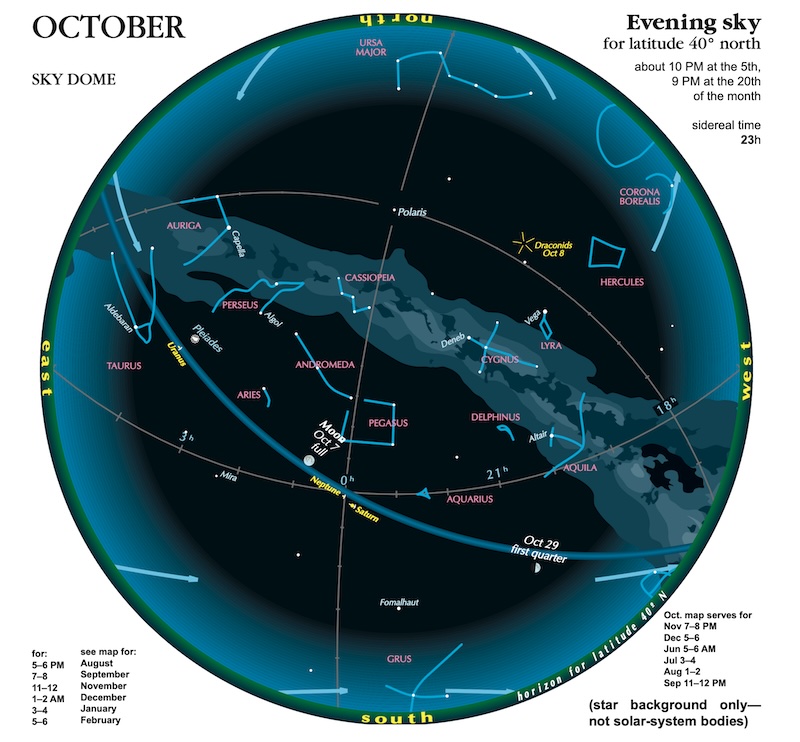 Here is the sky dome view for October 2025. It shows what is above the horizon at mid-evening for mid-northern latitudes. The view may vary depending on your location. Image via Guy Ottewell’s 2025 Astronomical Calendar.
Here is the sky dome view for October 2025. It shows what is above the horizon at mid-evening for mid-northern latitudes. The view may vary depending on your location. Image via Guy Ottewell’s 2025 Astronomical Calendar.
Read more: Guy Ottewell explains sky dome maps.
Heliocentric solar system visible planets and more
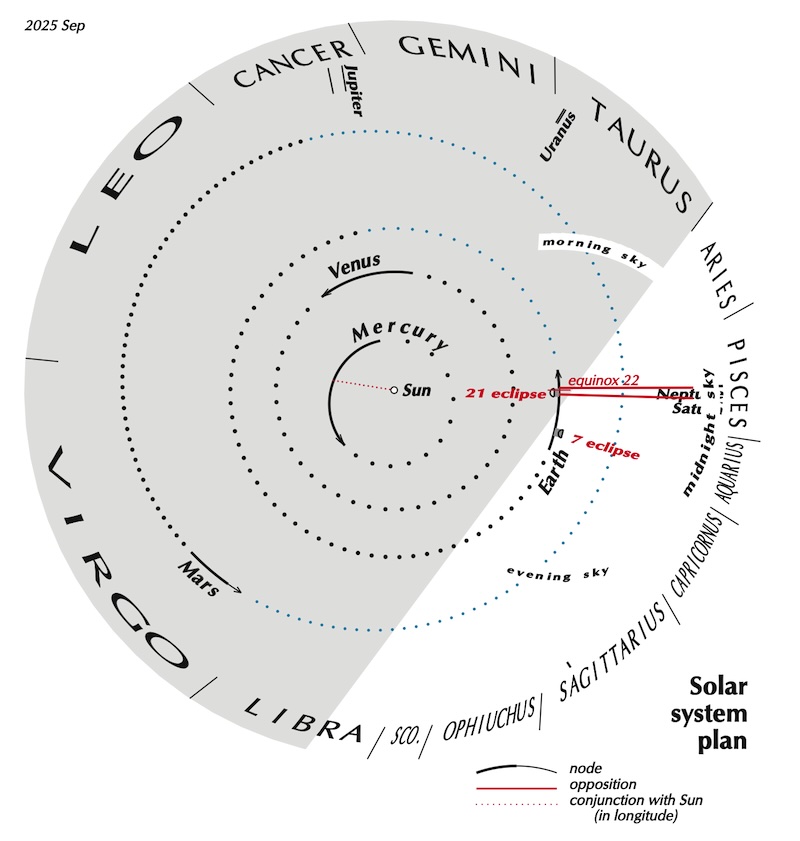 Heliocentric view of solar system, September 2025. Chart via Guy Ottewell’s 2025 Astronomical Calendar. Used with permission.
Heliocentric view of solar system, September 2025. Chart via Guy Ottewell’s 2025 Astronomical Calendar. Used with permission.
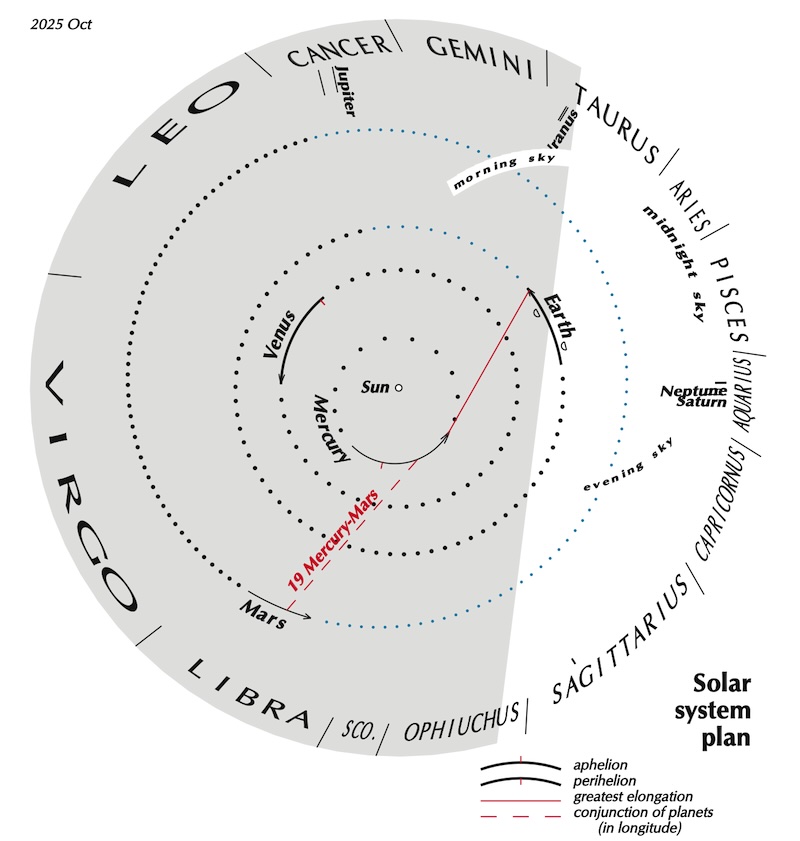 Heliocentric view of solar system, October 2025. Chart via Guy Ottewell’s 2025 Astronomical Calendar. Used with permission.
Heliocentric view of solar system, October 2025. Chart via Guy Ottewell’s 2025 Astronomical Calendar. Used with permission.
Read more: Guy Ottewell explains heliocentric charts.
Some resources to enjoy
For more videos of great night sky events, visit EarthSky’s YouTube page.
Don’t miss anything. Subscribe to daily emails from EarthSky. It’s free!
Visit EarthSky’s Best Places to Stargaze to find a dark-sky location near you.
Post your own night sky photos at EarthSky Community Photos.
See the indispensable Observer’s Handbook, from the Royal Astronomical Society of Canada.
Visit Stellarium-Web.org for precise views from your location.
Almanac: Bright visible planets (rise and set times for your location).
Visit TheSkyLive for precise views from your location.
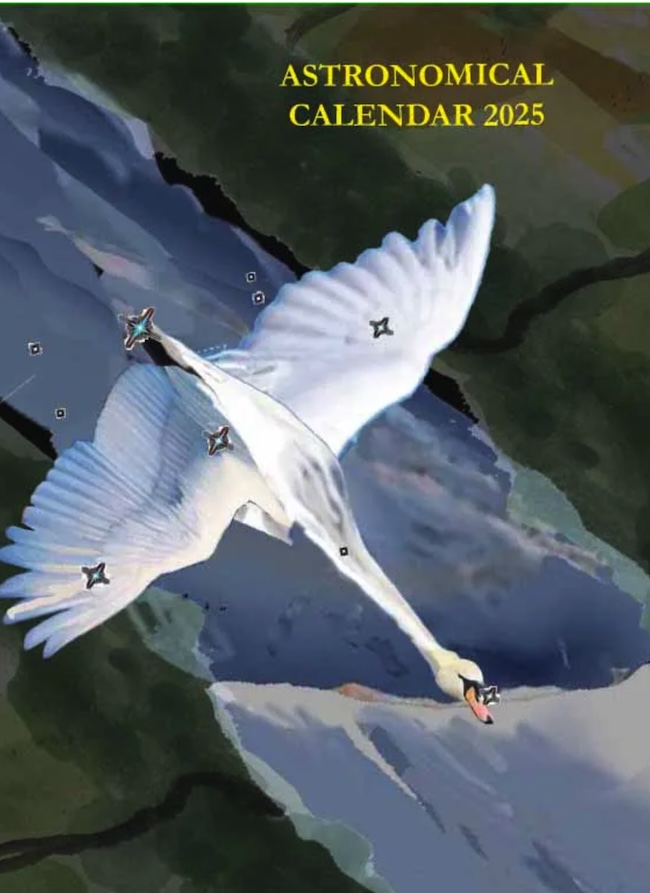 Attention amateur astronomers! Guy Ottewell’s popular and informative Astronomical Calendar for 2025 is available in both electronic and printed versions.
Attention amateur astronomers! Guy Ottewell’s popular and informative Astronomical Calendar for 2025 is available in both electronic and printed versions.
Bottom line: Visible planets and night sky guide. This evening, look for the waxing moon with its crescent pointing toward red Mars, which is near the western horizon. Don’t miss the video about Comet C/2025 R2 (SWAN).
John Jardine Goss
View Articles
About the Author:
“I can sometimes see the moon in the daytime” was a cosmic revelation that John Jardine Goss first discovered through personal observations at age 6. It shook his young concept of the universe and launched his interest in astronomy and stargazing, a fascination he still holds today. John is past president of the Astronomical League, the largest U.S. federation of astronomical societies, with over 24,000 members. He’s earned the title of Master Observer and is a regular contributor to the video series, “Global Star Party.” He has authored the celestial observing guides “Exploring the Starry Realm,” and “Carpe Lunam,” and “Take Your First Steps, an Introduction to Amateur Astronomy.” John also wrote for twenty years the monthly stargazing column, Roanoke Skies, for the Roanoke Times, and currently writes a bimonthly column, Skywatch, for Blue Ridge Country magazine. He has contributed to Sky and Telescope magazine, the IDA Nightscape, the Astronomical League’s Reflector magazine, and the RASC Observer’s Handbook.
